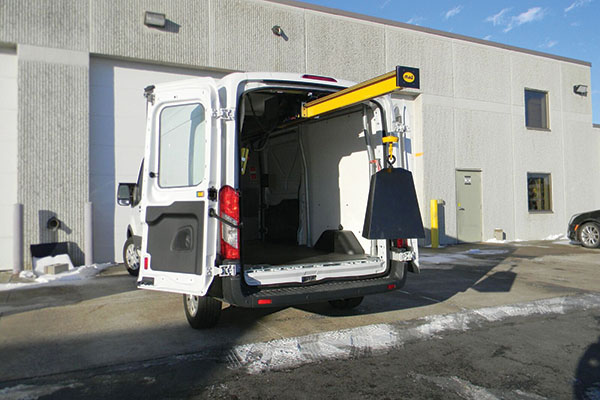Buckman Beverage employs dual-axis crane
The crane can extend up to 45.5 inches in length, reducing strain on employees.

When Buckman Beverage began its beer distribution business in Philadelphia, it had to use two very robust workers for every delivery. All kegs were either rolled down ramps, or manually lifted out of the back of vehicles and onto hand trucks.
The company was using Ford Transits with extended wheel bases for their deliveries and could only hire workers who were physically able to manage the demands of loading and unloading a vehicle’s payload of 25 kegs of beer.
And, the vans’ 20-foot vehicle lengths, coupled with their 8-foot ramps (which extended from the rear doors), made it difficult to park and offload in the city. The ramps often couldn’t be used to unload the 160-pound kegs.
“My business partners and I were in a constant state of anxiety, because manually lifting, sliding and rolling kegs of beer can pose physical challenges and cause property damage,” says Jim Buckman, president of Buckman Beverage. “We care about our workers, and it seemed there had to be a better way.”
So Buckman explored post-mounted hoists as an alternative. Unfortunately, post-mounted and fixed-axis cranes have an operational arc and can only lift and lower an object along the fixed trajectory of the crane’s arm, as it pivots around the single axis of the crane’s vertical post.
Although the arc’s size can increase or decrease by extending or retracting the crane arm, as a rule, no adjustment can be made under the load. Additionally, the lifting capacity of these cranes is generally diminished proportionately to the crane arm’s extension, sometimes reducing it to less than half the maximum load limit.
The single-axis cranes could help transport kegs in and out of vehicles, but once a keg is inside a vehicle, operators have no choice but to move it a second time—either manually or with a hand truck.
“A post-mounted crane was close, but no cigar,” Buckman adds. “So I kept searching.”
The search led to a crane that was an intelligent alternative to post-mounted and fixed-axis cranes. The crane remains inside vehicles and away from the elements. Yet, unlike post-mounted and fixed-axis cranes, it resides at ceiling height and above shelving.
It can also slide to either side of a vehicle or stow in the center of a cargo hold until it’s needed. Its boom is easily positioned because it can move on two axes, sliding laterally up to 8 feet (depending on the vehicle) and extending up to 45.5 inches in length.
“The crane not only offers better lifting characteristics, but has superior loading capabilities as well,” Buckman adds. “Unlike swiveling cranes that would do well to simply position a keg at the threshold of a cargo hold, the crane can take the keg well into the cargo space—forward of the vehicle’s rear axle, depositing it in an optimal position with its unique dual-axis precision.”
National Fleet Products
(763) 762-3440

Article Topics
Overhead Handling News & Resources
Monorail Manufacturers Association celebrates 90 years of monorail best practices Are Your Crane Operations Stuck in the Past? Demag demonstrates DCBS Electric Balancer and other light lifting capabilities Report: Global crane and hoist market to see 5.22% CAGR over 2020-2027 CMAA announces updates for two specifications Overhead lifting safety webinar series set for September Are exoskeletons the X factor for industrial workers? More Overhead HandlingLatest in Materials Handling
Beckhoff USA opens new office in Austin, Texas Manhattan Associates selects TeamViewer as partner for warehouse vision picking ASME Foundation wins grant for technical workforce development The (Not So) Secret Weapons: How Key Cabinets and Asset Management Lockers Are Changing Supply Chain Operations MODEX C-Suite Interview with Harold Vanasse: The perfect blend of automation and sustainability Consultant and industry leader John M. Hill passes on at age 86 Registration open for Pack Expo International 2024 More Materials HandlingSubscribe to Materials Handling Magazine

Find out what the world's most innovative companies are doing to improve productivity in their plants and distribution centers.
Start your FREE subscription today.
April 2024 Modern Materials Handling

Latest Resources










